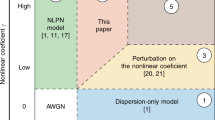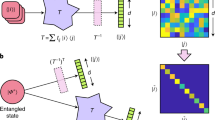Abstract
The exponential growth in the rate at which information can be communicated through an optical fibre is a key element in the ‘information revolution’. However, as for all exponential growth laws, physical limits must be considered. The nonlinear nature of the propagation of light in optical fibre has made these limits difficult to elucidate. Here we use a key simplification to investigate the theoretical limits to the information capacity of an optical fibre arising from these nonlinearities. The success of our approach lies in relating the nonlinear channel to a linear channel with multiplicative noise, for which we are able to obtain analytical results. In fundamental distinction to linear channels with additive noise, the capacity of a nonlinear channel does not grow indefinitely with increasing signal power, but has a maximal value. The ideas presented here may have broader implications for other nonlinear information channels, such as those involved in sensory transduction in neurobiology. These have been often examined using additive noise linear channel models1 but, as we show here, nonlinearities can change the picture qualitatively.
This is a preview of subscription content, access via your institution
Access options
Subscribe to this journal
Receive 51 print issues and online access
$199.00 per year
only $3.90 per issue
Buy this article
- Purchase on Springer Link
- Instant access to full article PDF
Prices may be subject to local taxes which are calculated during checkout

Similar content being viewed by others
References
Shannon, C. E. A mathematical theory of communications. Bell Syst. Tech. J. 27, 379–423, 623–656 (1948).
Biglieri, E., Proakis, J. & Shamai, S. Fading channels: Information-theoretic and communications aspects. Inform. Theory Trans. 44, 2619–2692 (1998).
Kogelnik, H. High-capacity optical communication. IEEE Sel. Topics Quant. Elec. 6(6), 1279 (2000).
Agrawal, G. P. Nonlinear Fiber Optics (Academic, San Diego, 1995).
Desurvire, E. Erbium Doped Fibre Amplifiers 69 (Wiley, New York, 1994).
Cover, T. M. & Thomas, J. A. Information Theory 374–458 (Wiley, New York, 1991).
Feynman, R. P. & Hibbs, R. A. Quantum Mechanics and Path Integrals (McGraw-Hill, New York, 1963).
Acknowledgements
We gratefully acknowledge extensive discussions with E. Telatar, and also with A. Green, P. B. Littlewood, R. Slusher, A. Chraplyvy and G. Foschini. We thank M. Povinelli and L. Wegener for performing numerical and analytical computations to verify the considerations in this Letter, and D. R. Hamann and R. Slusher for careful readings of the manuscript.
Author information
Authors and Affiliations
Corresponding author
Rights and permissions
About this article
Cite this article
Mitra, P., Stark, J. Nonlinear limits to the information capacity of optical fibre communications. Nature 411, 1027–1030 (2001). https://doi.org/10.1038/35082518
Received:
Accepted:
Issue Date:
DOI: https://doi.org/10.1038/35082518
This article is cited by
-
Handling mode and polarization in fiber by fs-laser inscribed (de)multiplexer and silicon switch array
PhotoniX (2023)
-
Tbit/s line-rate satellite feeder links enabled by coherent modulation and full-adaptive optics
Light: Science & Applications (2023)
-
Design of an ultracompact 3-input majority gate using photonic crystal
ISSS Journal of Micro and Smart Systems (2023)
-
Shaping lightwaves in time and frequency for optical fiber communication
Nature Communications (2022)
-
Effect of shift in refractive index of dispersive elements in waveband-shift-free optical-phase conjugator based on DFG
Optical Review (2021)
Comments
By submitting a comment you agree to abide by our Terms and Community Guidelines. If you find something abusive or that does not comply with our terms or guidelines please flag it as inappropriate.



